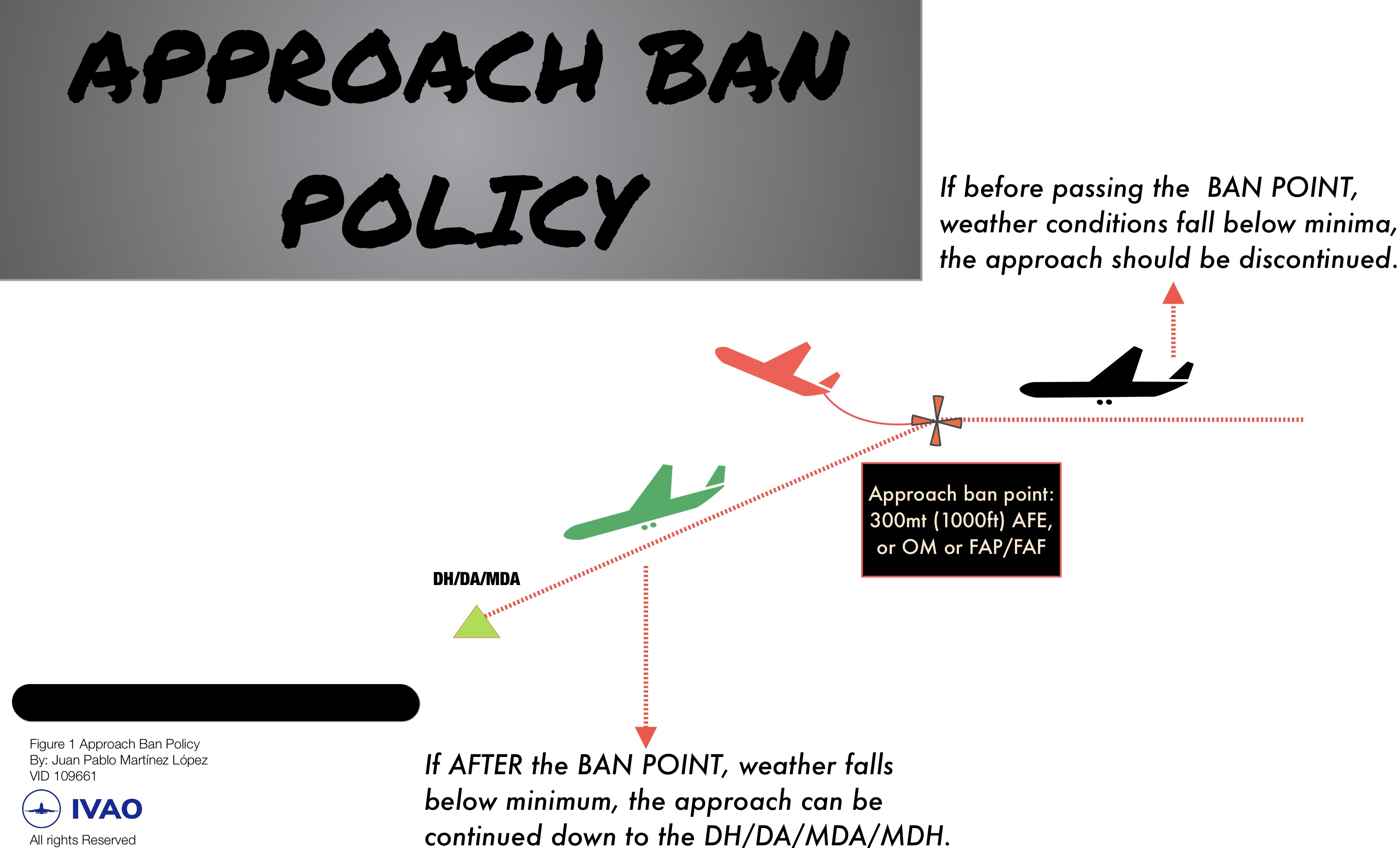¶ Introduction
When it comes to instrument approach procedures during IMC, one very important concept that pilots should be familiar with, is the "Approach Ban Policy", also referred to as "Commencement and Continuation of the Approach".
This practical rule applies to arriving aircraft when weather conditions are reported to be below minima just to facilitate the pilot in command decision making process, as well as to minimize unnecessary approaches where a successful landing would be unlikely due to weather.
Basically, this policy limits the flight crew from proceeding beyond a point on an IAP, unless weather conditions satisfy the required minima for the approach.
We will now hightlight the most important aspects applicable to ICAO, EASA and FAA regulations.
Attention: This concept may vary among states, or simply may not be permitted. Check your own local regulations for more information.
¶ ICAO: Approach Ban Policy
According to Annex 6 Part I and II, for both commercial operators and general aviation respectively (Chapter: Flight Procedures), "An instrument approach shall not be continued beyond the outer marker fix or the beginning of the final approach segment in case of precision approach, or below 300mt (1000ft) above the aerodrome in case of non-precision approach, unless the reported visibility or controlling RVR is above the required minimum."
If after passing these references, the weather deteriorates and the reported visibility or controlling RVR falls below the required minimum, the policy allows to continue the approach down to DA/H or MDA/H.
Note: ICAO defines "Controlling RVR" as the reported values of one or more RVR reporting locations (touchdown, mid-point and stop-end) used to determine whether operating minima are or are not met. Where RVR is used, the controlling RVR is the touchdown RVR, unless otherwise specified by State criteria.
¶ EASA: Commencement and Continuation of the Approach
According to EASA (CAT.OP.MPA.305), the pilot may commence an approach regardless of the reported visibility or RVR. However, the approach cannot be continued if the reported VIS/RVR is less than the applicable minimum:
- below 1000ft AFE, or
- into the final approach segment if the DA/MDA/MDH is located above 1000ft AFE.
If after passing 1000ft, the reported conditions fall below the applicable minimum, the approach can be continued down to DA/MDA/DH/MDH.
The approach can be continued below DH/DA/MDA and landing can be completed if sufficient visual references are established and maintained for the type of approach.
The touchdown zone RVR shall always be controlling.
However, the midpoint and stop-end RVRs shall also be controlling if reported and if "relevant" (see note below). The minimum RVR for the MID shall be 125mt or the RVR required for the TDZ if less, and 75mt for the stop-end. For those aircraft equipped with a rollout guidance or control system, the minimum RVR value for the MID shall be 75m.
Note: The term "relevant" refers to the portion of the RWY used during the high-speed phase of the landing down to 60KT approximately.
¶ FAA
According to FAA, a similar concept applies within the regulations regarding Take-off, Approach and Landing minima. However, not all commercial operations are allowed to do it.
14 FAR 135.225 states that "no pilot may begin the final approach segment of an IAP unless the latest weather reported indicates that the conditions are at or above the authorized IFR landing minimums for that procedure."
If a pilot who has begun the final approach segment receives a later weather report indicating that conditions have gone below the minimum requirements, the approach may be continued only if the following conditions are met:
1. The later weather report is received when the aircraft is in one of the following approach phases:
- the aircraft is on an ILS final approach and has already passed the FAP;
- the aircraft is on an ASR or PAR final approach and has been turned over to the final approach controller; or
- the aircraft is on a non-precision final approach and the aircraft:
(A) has passed the appropriate facility or FAF; or
(B) where a FAF is not specified, it has completed the procedure turn and is established on the final approach course within the distance prescribed in the procedure.
2. Upon reaching MDA or DA/DH, the pilot finds that the actual weather conditions are at or above the minimums prescribed for the procedure.
¶ Graphical Explanation
Here you'll find a picture which summarizes the concept into a general idea:

- ICAO ANNEX 6
- EASA Regulations
- All weather operations manual
- FAA Regulations
- VID 109661 - Creation
- VID 496402 - Wiki.js integration